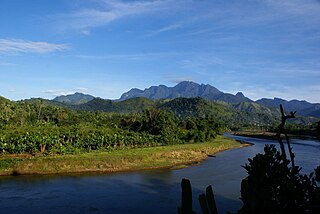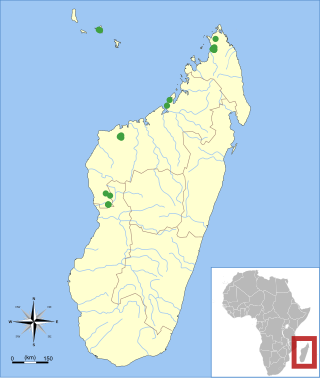
Macrobrachium rosenbergii, also known as the giant river prawn or giant freshwater prawn, is a commercially important species of palaemonid freshwater prawn. It is found throughout the tropical and subtropical areas of the Indo-Pacific region, from India to Southeast Asia and Northern Australia. The giant freshwater prawn has also been introduced to parts of Africa, Thailand, China, Japan, New Zealand, the Americas, and the Caribbean. It is one of the biggest freshwater prawns in the world, and is widely cultivated in several countries for food. While M. rosenbergii is considered a freshwater species, the larval stage of the animal depends on brackish water. Once the individual shrimp has grown beyond the planktonic stage and becomes a juvenile, it lives entirely in fresh water.

Ankarana Special Reserve is a protected area in northern Madagascar created in 1956. It is a small, partially vegetated plateau composed of 150-million-year-old middle Jurassic limestone. With an average annual rainfall of about 2,000 millimetres (79 in), the underlying rocks have been eroded to produce caves and feed subterranean rivers—a karst topography. The rugged relief and the dense vegetation have helped protect the region from human intrusion.

Cryptoprocta spelea, also known as the giant fossa, is an extinct species of carnivore from Madagascar in the family Eupleridae which is most closely related to the mongooses and includes all Malagasy carnivorans.

The silky sifaka is a large lemur characterized by long, silky, white fur. It has a very restricted range in northeastern Madagascar, where it is known locally as the simpona. It is one of the rarest mammals on Earth. The silky sifaka is one of nine sifaka species, and one of four former subspecies of diademed sifaka (P. diadema). Studies in 2004 and 2007 compared external proportions, genetics, and craniodental anatomy supporting full species status, which has generally been accepted.

Marojejy National Park is a national park in the Sava region of northeastern Madagascar. It covers 55,500 ha (214 sq mi) and is centered on the Marojejy Massif, a mountain chain that rises to an elevation of 2,132 m (6,995 ft). Access to the area around the massif was restricted to research scientists when the site was set aside as a strict nature reserve in 1952. In 1998, it was opened to the public when it was converted into a national park. It became part of the World Heritage Site known as the Rainforests of the Atsinanana in 2007. "Unique in the world, a place of dense, jungly rainforests, sheer high cliffs, and plants and animals found nowhere else on earth", Marojejy National Park has received plaudits in the New York Times and Smithsonian Magazine for its natural beauty and rich biodiversity that encompasses critically endangered members of the silky sifaka. To that end, a global consortium of conservation organizations, including the Lemur Conservation Foundation, Duke Lemur Center and Madagascar National Parks, have sought to promote research and conservation programs in Marojejy National Park, neighboring Anjanaharibe-Sud Reserve and Antanetiambo Private Reserve, to protect the endemic flora and fauna that reside in northeastern Madagascar. In addition, these organizations have implemented a variety of community-based initiatives to mitigate human encroachment on the park, such as poaching and selective logging, by encouraging local communities to engage in afforestation and silvicultural initiatives to promote a sustainable alternative to mining, slash-and-burn agriculture, and wood collection.

Zombitse-Vohibasia is a national park in the Atsimo-Andrefana region of south-west Madagascar. It is 147 kilometres (91 mi) north-east of the town of Toliara on the National road 7.

Macrobrachium ohione, commonly known as the Ohio shrimp, Ohio river shrimp or Ohio river prawn, is a species of freshwater shrimp found in rivers throughout the Gulf of Mexico and Atlantic Ocean drainage basins of North America. It is the best-known of all North American freshwater shrimp, and is commonly used as bait for commercial fishing, especially catfish.

Macrobrachium is a genus of freshwater prawns or shrimps characterised by the extreme enlargement of the second pair of pereiopods, at least in the male.

Miniopterus aelleni is a bat in the genus Miniopterus that occurs on Anjouan in the Comoros and in northern and western Madagascar.

Miniopterus griveaudi is a bat in the genus Miniopterus found on Grande Comore and Anjouan in the Comoros and in northern and western Madagascar. First described in 1959 from Grande Comore as a subspecies of the mainland African M. minor, it was later placed with the Malagasy M. manavi. However, morphological and molecular studies published in 2008 and 2009 indicated that M. manavi as then defined contained five distinct, unrelated species, and M. griveaudi was redefined as a species occurring on both Madagascar and the Comoros.

Durrell's vontsira is a small, reddish-brown, fox-like mammal native to the island of Madagascar. Discovered in 2004, it lives only in the biodiverse wetlands of Lake Alaotra. Durrell's vontsira belongs to the family Eupleridae, a group of meat-eating, cat- or fox-like mammals found only on Madagascar. The species is closely related to the brown-tailed mongoose, with which it forms the genus Salanoia. The two are genetically similar, but morphologically distinct, and S. durrelli was described as a new species in 2010.

Petter's big-footed mouse, is a Madagascan rodent in the genus Macrotarsomys. With a head and body length of 150 mm (5.9 in) and body mass of 105 g (3.7 oz), it is the largest species of its genus. Its upper body is brown, darkest in the middle of the back, and the lower body is white to yellowish. The animal has long whiskers, short forelimbs, and long hindfeet. The tail ends in a prominent tuft of long, light hairs. The skull is robust and the molars are low-crowned and cuspidate.

Macrobrachium carcinus is a species of fresh water shrimp known as the big claw river shrimp. It is native to streams, rivers and creeks from Florida to southern Brazil. It is the largest known species of Neotropical freshwater prawn, growing up to 30 centimetres (12 in) long and weighing as much as 850 grams (30 oz), although even larger specimens have been reported. It is an important species for commercial fishing in the Sao Francisco River basin, where it is known by the local name of pitu. M. carcinus is omnivorous, with a diet consisting of molluscs, small fish, algae, leaf litter and insects.

Brookesia bonsi is a species of chameleons, a lizard in the family Chamaeleonidae. The species is endemic to Madagascar, and was initially described by Guy A. Ramanantsoa in 1980. The International Union for Conservation of Nature ranked this species as Critically Endangered.

The flora of Madagascar consists of more than 12,000 species of plants, as well as a poorly known number of fungi and algae. Around 83% of Madagascar's vascular plants are found only on the island. These endemics include five plant families, 85% of the over 900 orchid species, around 200 species of palms, and such emblematic species as the traveller's tree, six species of baobab and the Madagascar periwinkle. The high degree of endemism is due to Madagascar's long isolation following its separation from the African and Indian landmasses in the Mesozoic, 150–160 and 84–91 million years ago, respectively. However, few plant lineages remain from the ancient Gondwanan flora; most extant plant groups immigrated via across-ocean dispersal well after continental break-up.

Macrobrachium malcolmsonii is an omnivorous, bottom-dwelling, freshwater prawn. Its common name is monsoon river prawn.
Knowledge and Management of Aquatic Ecosystems is a peer-reviewed open access scientific journal covering management and conservation issues related to freshwater ecosystems. The journal publishes articles, short communications, reviews, comments and replies. It is published by EDP Sciences and the editor-in-chief is Thierry Oberdorff (IRD). The journal was established in 1928 as Bulletin Français de la Pêche et de la Pisciculture and obtained its current title in 2008.

The ACMAT Bastion is a modern French armoured personnel carrier, manufactured by ACMAT.
Macrobrachium zariquieyi is a freshwater prawn belonging to the genus Macrobrachium and the family Palaemonidae. It is found in West Africa and reported in Côte d'Ivoire river. The species name of this species is dedicated to Ricardo Zariquiey who worked on Spanish decapods.

Macrobrachium scabriculum is a species of freshwater shrimp. It is distributed in countries and territories around the Indian Ocean. It is known as Goda River prawn. The total length of male prawns become about 6.5 cm long and in females it is about 5 cm. A kind of fur develop on the chelipeds of males. Eggs produced by M. scabriculum are smaller in size, brownish in color, elliptical or oval in shape and hatched larvae undergone migration to low saline water for completion its life cycle.
















